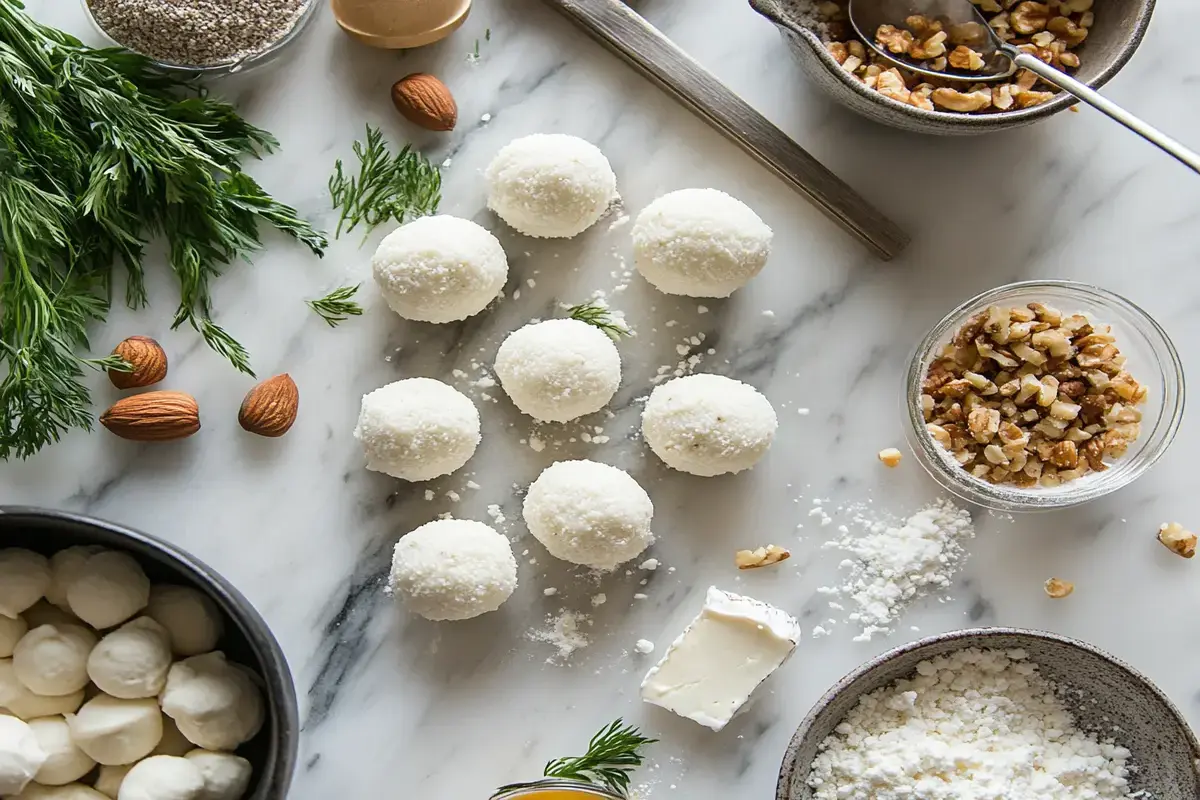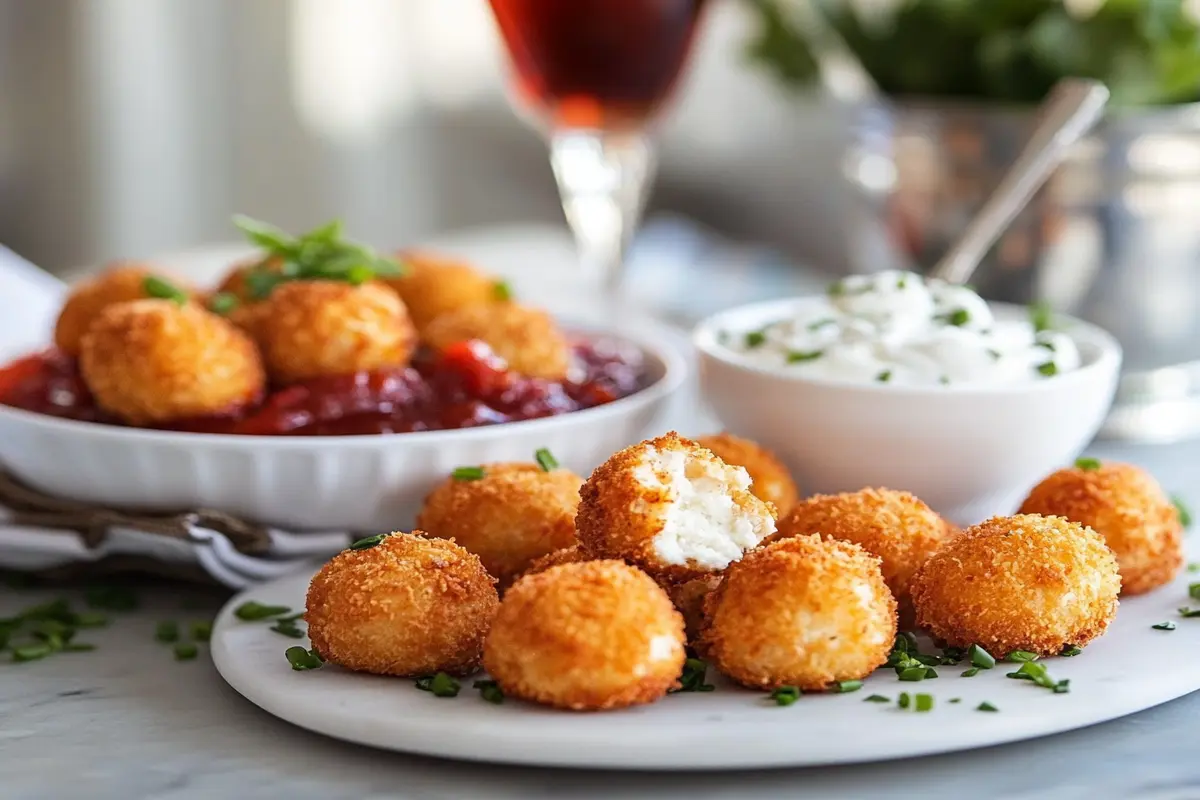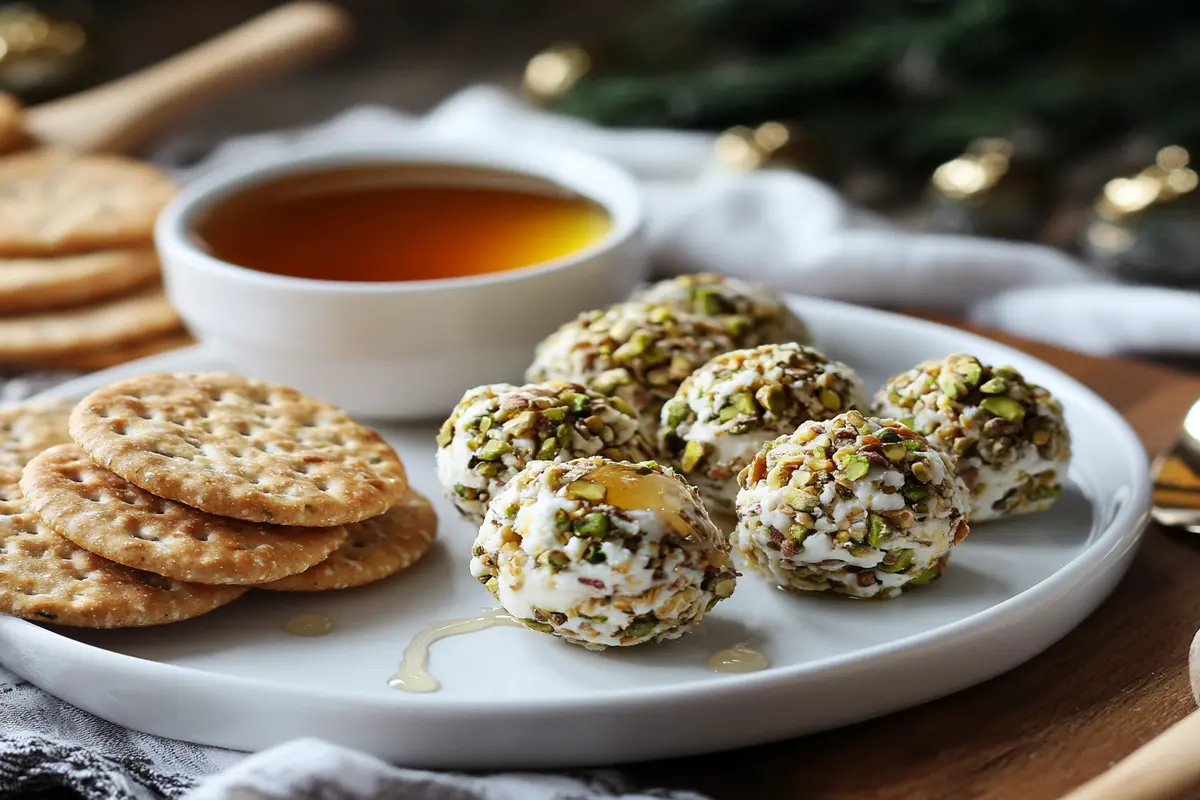There’s something undeniably charming about goat cheese balls. These creamy, tangy bites are the ultimate crowd-pleaser, whether you’re serving them as appetizers at a party or adding them to a salad for a gourmet twist. This guide will take you through every step of creating the perfect goat cheese balls recipe. From selecting the best ingredients to mastering cooking techniques and exploring creative variations, you’ll have all the tools to wow your guests (or yourself!). Let’s get rolling!
Introduction to Goat Cheese Balls
What Are Goat Cheese Balls?
At their core, goat cheese balls are small, bite-sized portions of goat cheese that are shaped into rounds and coated with delicious toppings. These coatings can range from crunchy nuts and fresh herbs to breadcrumbs and even sweet ingredients like honey and dried fruit. Depending on the preparation, they can be served chilled, baked, or fried.
The goat cheese balls recipe is incredibly versatile, making it a favorite among chefs and home cooks alike. You can serve them as an appetizer, snack, or even as part of a main course.
Why Goat Cheese is Perfect for Appetizers
Goat cheese’s tangy, creamy flavor makes it a standout ingredient in appetizers. Its unique taste pairs well with a wide variety of flavors, from savory herbs to sweet honey. Moreover, the texture of goat cheese allows it to be easily molded, coated, and cooked, making it ideal for this recipe. Plus, it’s naturally gluten-free and rich in nutrients like calcium and protein.
The Versatility of Goat Cheese Balls in Different Cuisines
Whether you’re hosting an Italian-inspired dinner or preparing a Mediterranean spread, goat cheese balls fit right in. Add a hint of garlic and oregano for a Greek twist, or drizzle them with balsamic glaze for a sophisticated Italian flavor. Their adaptability ensures they’ll complement almost any dish, making them a staple for adventurous cooks.
Ingredients for Goat Cheese Balls Recipe
Essential Ingredients for Goat Cheese Balls
Creating the perfect goat cheese balls recipe begins with fresh, high-quality ingredients. Here’s what you’ll need:
- Goat Cheese: Soft and creamy goat cheese is the star of this recipe. Choose a plain variety to allow the coatings and seasonings to shine.
- Coatings: Popular options include crushed nuts like pistachios or almonds, fresh herbs such as parsley or dill, or crispy breadcrumbs for a crunchy texture.
- Seasonings: A pinch of garlic powder, a drizzle of honey, or a sprinkle of paprika can elevate the flavor profile.
- Optional Additions: For extra flair, include dried cranberries, sesame seeds, or even chili flakes for a spicy kick.
Optional Additions and Variations
Want to experiment? Try incorporating these ideas into your goat cheese balls recipe:
- Mix honey and thyme into the cheese before shaping for a sweet-savory balance.
- Roll the balls in toasted coconut flakes for a tropical twist.
- Add a small piece of sun-dried tomato to the center of each ball for a surprise burst of flavor.
Choosing the Right Type of Goat Cheese
Not all goat cheese is created equal. Soft chèvre is ideal for this recipe because of its creamy texture, which makes it easy to shape. If you prefer a tangier flavor, opt for aged goat cheese. For more inspiration, explore this shrimp garlic recipe – butter based for another elegant dish that pairs beautifully with appetizers.
Step-by-Step Preparation of Goat Cheese Balls
Shaping and Chilling the Goat Cheese Mixture
The first step in making a goat cheese balls recipe is shaping the cheese. Scoop small portions of goat cheese using a teaspoon or melon baller. Roll them gently between your palms to form smooth, even balls. Once shaped, place the balls on a lined baking tray and refrigerate for at least 30 minutes. Chilling helps them firm up, making it easier to coat and cook them later.
Coating Options: Nuts, Herbs, and More
Coating the goat cheese balls is where creativity takes center stage. Place your chosen coatings (like crushed nuts, breadcrumbs, or herbs) into separate shallow bowls. Roll each chilled ball in the coating until fully covered. For a gourmet touch, combine coatings—like mixing breadcrumbs with Parmesan or adding a pinch of cayenne to the nuts.
Frying vs. Baking: Choosing Your Cooking Method
Decide between frying or baking your goat cheese balls based on the texture you prefer:
- Frying: Heat oil in a pan and fry the coated balls until golden brown. This method delivers a crispy exterior while keeping the cheese warm and gooey inside.
- Baking: Preheat your oven to 375°F (190°C). Place the balls on a parchment-lined tray and bake for 10–12 minutes, or until lightly browned. Baking is a healthier alternative that still offers great texture.

Serving and Pairing Goat Cheese Balls
What Does Goat Cheese Taste Best With?
A goat cheese balls recipe offers endless pairing possibilities. These tangy, creamy bites pair beautifully with fresh fruits like grapes, figs, or apple slices. For a sweet-savory balance, drizzle them with honey or serve alongside a fig jam. On the savory side, they shine with crusty bread, crackers, or fresh vegetables like celery and bell pepper slices.
For a Mediterranean-inspired twist, serve them with marinated olives and sun-dried tomatoes. Their bold flavors contrast perfectly with the mild creaminess of goat cheese.
Pairing Goat Cheese Balls with Drinks and Dips
When it comes to drinks, goat cheese balls pair wonderfully with sparkling wines like Prosecco or a crisp Sauvignon Blanc. These wines cut through the richness of the cheese, refreshing your palate with every sip. Beer lovers can opt for a light ale or a citrusy IPA.
Dips also add versatility to a goat cheese balls recipe. Try pairing them with balsamic glaze, herb-infused olive oil, or a creamy garlic aioli for dipping. These flavors enhance the cheese’s tangy profile while adding layers of depth.
Creative Plating Ideas for Goat Cheese Balls
Presentation matters, especially if you’re serving these at a gathering. Arrange the goat cheese balls on a rustic wooden platter with a mix of fresh herbs, nuts, and fruits. For an elegant touch, sprinkle the platter with edible flowers or pomegranate seeds. This not only adds color but also makes the dish visually inviting.

Variations of Goat Cheese Balls Recipes
Sweet Goat Cheese Balls with Honey and Nuts
For a sweet take on the classic goat cheese balls recipe, mix a bit of honey into the cheese before shaping. Roll the balls in crushed pecans or walnuts for a nutty crunch, then drizzle with additional honey before serving. These make an excellent dessert or a delightful addition to a brunch spread.
Spicy Goat Cheese Balls with Jalapeños
Add a fiery kick to your recipe by incorporating finely chopped jalapeños or a pinch of cayenne pepper into the goat cheese mixture. Coat the balls in seasoned breadcrumbs or crushed tortilla chips for an extra layer of spice. These are perfect for game day snacks or any gathering where you want bold flavors to stand out.
Low-Carb and Gluten-Free Options
If you’re looking for a lighter version of a goat cheese balls recipe, skip the breadcrumbs and roll the cheese in crushed almonds, pistachios, or sesame seeds. Baking instead of frying further reduces the calorie count while maintaining a satisfying crunch. These low-carb, gluten-free versions are great for guests with dietary restrictions.
For more ideas on creating appetizers, check out this guide to shrimp garlic recipe – butter based, another crowd-pleaser that’s sure to impress.
Health Benefits of Goat Cheese
Is Goat Cheese Healthier than Cow’s Milk Cheese?
When comparing goat cheese to cow’s milk cheese, goat cheese often comes out on top for its health benefits. It’s lower in calories and fat, making it a lighter option for those watching their intake. Goat cheese also contains less lactose, making it easier to digest for people who are lactose intolerant.
Using goat cheese in a goat cheese balls recipe adds nutritional value without sacrificing flavor. It’s packed with essential nutrients like calcium, phosphorus, and vitamin B12, all of which support bone health and energy production.
Nutritional Highlights of Goat Cheese Balls
Goat cheese is also rich in probiotics, which promote gut health and support the immune system. When paired with healthy coatings like nuts and seeds, your goat cheese balls recipe becomes a nutrient-dense snack or appetizer that’s both delicious and good for you.
FAQs About Goat Cheese Balls Recipe
What Does Goat Cheese Taste Best With?
Goat cheese’s creamy, tangy flavor pairs well with a wide variety of foods. In a goat cheese balls recipe, it tastes best with sweet ingredients like honey or dried fruits and savory options like roasted vegetables or artisan bread. Its versatility makes it a great addition to any spread.
Is Goat Cheese Healthier than Cow’s Milk Cheese?
Yes, goat cheese offers several health advantages over cow’s milk cheese. It’s easier to digest and contains fewer calories while delivering comparable amounts of protein and calcium. It’s also less likely to cause inflammation, making it a healthier choice for many people.
Is Goat Cheese a Good Melting Cheese?
Goat cheese isn’t the best melting cheese due to its low moisture content, but it softens beautifully when warmed. This makes it perfect for recipes like baked goat cheese balls or as a topping for flatbreads and salads.
Is Goat Cheese Good for Arthritis?
Yes, goat cheese may help manage arthritis symptoms. It’s lower in inflammatory fats compared to cow’s milk cheese and contains anti-inflammatory compounds. Adding goat cheese to your goat cheese balls recipe can be a flavorful way to include more anti-inflammatory foods in your diet.
Common Mistakes to Avoid When Making Goat Cheese Balls
Overmixing the Cheese: Maintaining the Right Texture
One common mistake when making a goat cheese balls recipe is overmixing the cheese. Overmixing can make the goat cheese too soft, making it harder to shape and more prone to falling apart. To avoid this, mix the cheese just enough to combine any additional flavors or ingredients without compromising its creamy texture.
Preventing Coating from Falling Off
Another frequent issue is the coating falling off during cooking. To ensure the coating sticks, chill the goat cheese balls after rolling them in your chosen crust. This step helps the coating adhere better, whether you’re frying or baking the balls. Additionally, lightly press the coating onto the cheese for a more secure bond.
Avoiding Soggy or Greasy Results
If you’re frying your goat cheese balls, the oil temperature is key. Too low, and your balls will absorb excess oil and become greasy; too high, and the exterior may burn before the cheese inside is warmed through. Aim for medium-high heat and test the oil with a small piece of coating before frying.
Conclusion and Final Thoughts
Why Goat Cheese Balls are a Must-Try Recipe
A goat cheese balls recipe is more than just an appetizer—it’s a versatile dish that can complement almost any meal. Whether paired with sweet fruits or savory breads, these creamy, tangy bites are sure to impress. Their adaptability makes them perfect for casual get-togethers or formal dinner parties.
Adding goat cheese to your diet also comes with nutritional perks. You may wonder, is goat cheese healthier than cow’s milk cheese? The answer is often yes! Goat cheese is lower in calories and easier to digest, making it a smart choice for health-conscious food lovers.
Encouraging Readers to Experiment with Variations
Now that you know how to make the perfect goat cheese balls recipe, it’s time to get creative. Try experimenting with different coatings, add unique spices to the mix, or pair them with unexpected sides. The possibilities are endless, and each variation brings a fresh twist to this classic recipe.
If you enjoyed this guide, check out other appetizer recipes on this website for more culinary inspiration! Let me know if you’d like me to polish the entire article or make additional tweaks.

